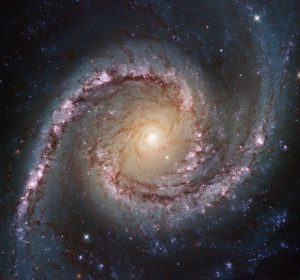Vortici Maestosi da Hubble
Questa immagine mozzafiato ripresa dal telescopio Hubble mostra NGC 1566, una splendida galassia situata a circa 40 milioni di anni luce di distanza nella costellazione del Dorado. NGC 1566 è una galassia a spirale intermedia: anche se non ha una regione di stelle ben definita a forma di barra al suo centro, come le spirali barrate, non è nemmeno una spirale non barrata.
Il suo piccolo nucleo, estremamente brillante, è chiaramente visibile in questa immagine, segno rivelatore della sua appartenenza alla classe delle galassie di Seyfert. I centri di queste galassie sono molto attivi e luminosi, emettono radiazioni energetiche e potenzialmente ospitano buchi neri supermassicci con una massa molti milioni di volte maggiore di quella solare.
NGC 1566 è la seconda galassia di Seyfert più luminosa conosciuta. È anche l’oggetto più brillante e più importante del gruppo del Dorado, un insieme di galassie che forma uno dei gruppi più ricchi nell’emisfero australe. L’immagine mette in evidenza la maestosa bellezza di questa galassia dall’aria scintillante, con il suo nucleo luminoso incorniciato da bracci vorticosi e simmetrici.
[ Barbara Bubbi ]
https://www.nasa.gov/content/hubble/grand-swirls-from-nasas-hubble
Image Credit: ESA/Hubble & NASA

Lascia un commento